Are you looking to fix EFS_FATAL_ERROR in Windows 10? This Blue Screen of Death problem has bugcheck value 0x000001D7 leads the desktop area to freeze. Moreover, the most disturbing issue that happens is the device tends to restart automatically when completely affected by the bug.
EFS FATAL ERROR BSOD in Windows 10 can strike due to two major concerns. One side is incompatible, old and defective device drivers. Another side of the coin is missing system resources, DLL files as for malware infection, a collision of two same programs and similar stuff. Other reasons like incorrect memory allocation, defective areas in RAM and HDD, defective Windows image files and sometimes, using an additional Hard Disk can evolve the error. Since the issue has severe effects on Windows and can even cause permanent damage, we need to find a perfect way out to resolve it. Here, we will present some effective solutions to dismiss this BSOD error.
EFS_FATAL_ERROR Windows 10 Solutions
Here is how to fix EFS_FATAL_ERROR BSOD in Windows 10 –
1] Restrict Windows 10 From Automatic Rebooting
This is obvious that Windows tends to have automatic restarting in it quite often and that won’t help to resolve the issue properly. Regardless, this is the worst experience you might face. However, there is always hope in each problem. We can hold up this action and disable automatic rebooting. This will not actually to resolve the error but you will get a working environment for deploying other resolutions. Here is the method –
Try saving all the ongoing processes to avoid losing them accidentally. Then move with below tasks –
- Press Win+D and head to Desktop area straightway.
- Perform a right click on This PC icon and choose Properties.
- Once a separate window opens, choose Advanced system settings.
- From System properties wizard appearing next, jump into its Advanced tab.
- Reach out to Startup and Recovery area next.
- Select the Settings button from this place.
- Moving in the Startup and Recovery window, proceed for the System failure section.
- Make the box before Automatically restart option unchecked.
- Press Ok button to proceed on.

Now, Windows won’t restart automatically and you may have the proper environment for applying other processes. Head to the next resolutions.
2] Enter Safe Boot Mode to load basic applications only
Whenever, Windows indulged in some critical issues or affected with bugs, booting in the Safe Mode came out as rescuer from the very beginning. In this startup method, Windows loads only basic programs. As a result, most of the problems take leave. In the case of EFS_FATAL_ERROR BSOD, our next attempt will be performing this Safe Boot. Here is how to move on –
Step-1: Hover the mouse pointer to the left of Taskbar and eventually make a click on the Start menu.
Step-2: Hit a click on Power icon from there and select the Restart option and pressing the Shift key at the same time.
Step-3: Once Windows completes the first cycle of restarting, there will be a blue screen holding a few options. Choose Troubleshoot from there.
Step-4: Proceeding ahead to the next page, select Advanced options.
Step-5: On the succeeding page, hit a click on Startup Settings.
Step-6: Now, make a click on the Power cog located at the right bottom corner.
Step-7: Select Restart and let the device to reboot for the second time.
Step-8: Windows after restarting will provide a menu at the startup. You will have options to Boot in Safe Mode here as well.
Step-9: Press F4 button from keyboard continuously and enter into the Safe Mode.
3] Use Windows Blue Screen Troubleshooter to fix EFS_FATAL_ERROR BSOD
BSOD error like EFS_FATAL_ERROR can be so dangerous in its effect and can cause you severe fatality. Seeing the consequences, Microsoft stepped out and developed a new built-in tool to rectify the issue in Windows itself. Windows Blue Screen Troubleshooter was put forward in Fall Creators Update. The utility has the full potential to resolve the error smoothly. If the operating system is same or above of the Windows 10 Fall Creators Update, move with the below guidelines to access the tool –
- Make a combined press of “Win+I” hotkeys to open Windows Settings app.
- When the app arrives in the display, hover cursor to Update &Security region and eventually do a click on it.
- After moving to the next page, select Troubleshoot from the left layout.
- Jump ahead to the corresponding right side then.
- Come little down and choose Blue screen option.
- When it expands, hit Run the Troubleshooter from the pane.
Thus, Windows Blue Screen Troubleshooter will start taking necessary actions to fix EFS_FATAL_ERROR BSOD. When the process finishes, hopefully, there will be no more issues.
4] Dismiss viruses via Windows Security
Virus components are so notorious in their actions and we are no longer safe from them. Being present everywhere around the web, they can get entrance to the system easily when you make a click on a suspicious link in the mail or visit a malicious site. Once they are present in the system causes necessary OS files to deteriorate. As for the reason, EFS FATAL ERROR BSOD evolves in the Windows. To dismiss them, Windows Security comes as a savior. It’s a handy default utility in Windows. Perform the following tasks to resolve the threats in the app –
- Invoke Taskbar Search press by pressing Win+S hotkeys together.
- Type Security in the empty box provided here.
- Make a click on Windows Security when arrives in the result.
- Proceeding ahead to the app, choose Virus & threat protection from left overlay.
- Jump up to the alongside right and perform a click on the Scan options link.
- Once displayed, choose the radio button ahead of Full Scan.
- Moving ahead, select Scan now button from the tail end and begin detection process.
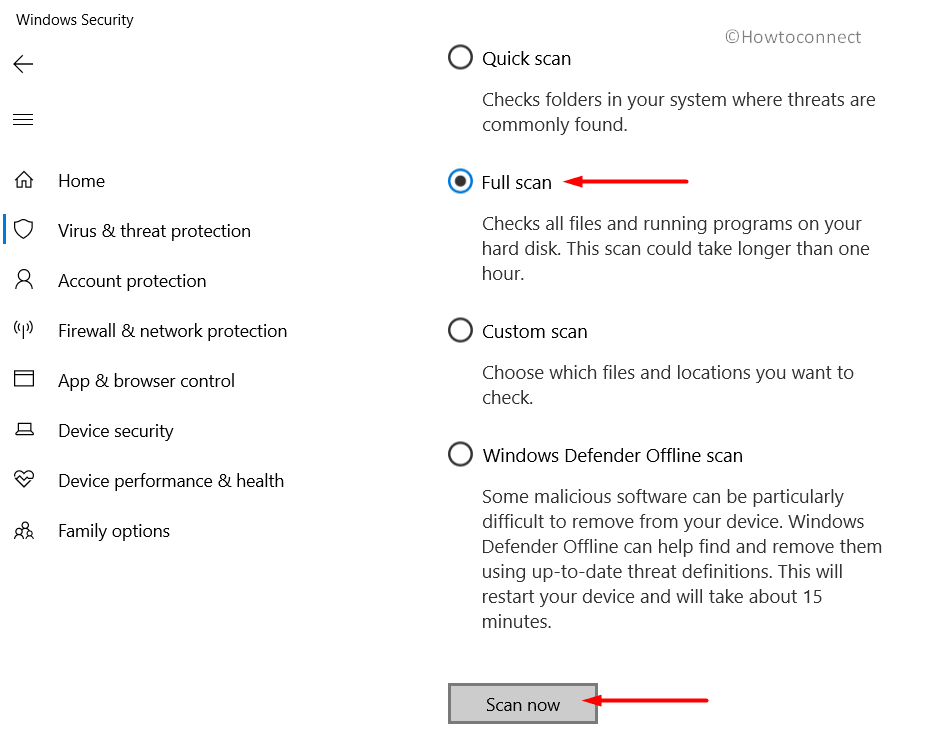
- Searching will begin in the system and you will see the result after ending the process.
- Now, hit the Clean threats option if the utility traces out some virus in the system.
- On the succeeding page, three option will be there for you.
- Choose Remove and at the same time, hit a click on the Start actions button to dismiss them from the computer.
5] Update all the drivers to Fix EFS_FATAL_ERROR
BSOD errors like EFS FATAL ERROR in Windows 10 mainly caused by incompatible and outdated device drivers. If you have left them in such condition for a long time, try updating them soonest. Windows Device Manager is the right platform to do so. You can easily identify the culprit drivers as indicated in yellow and update them in a single click. Here is the detailed process –
- Move the cursor over Taskbar area and in the end, make a right click on the Start menu.
- Invoke Run dialog on screen with the action.
- In the typing area, write devmgmt.msc in the text box and hit the Enter key.
- On the Device Manager console, have a deep look on the devices. If there is any mark of exclamation on a device, select it to expand.
- Once found, perform a right click on each driver and select Update driver option.
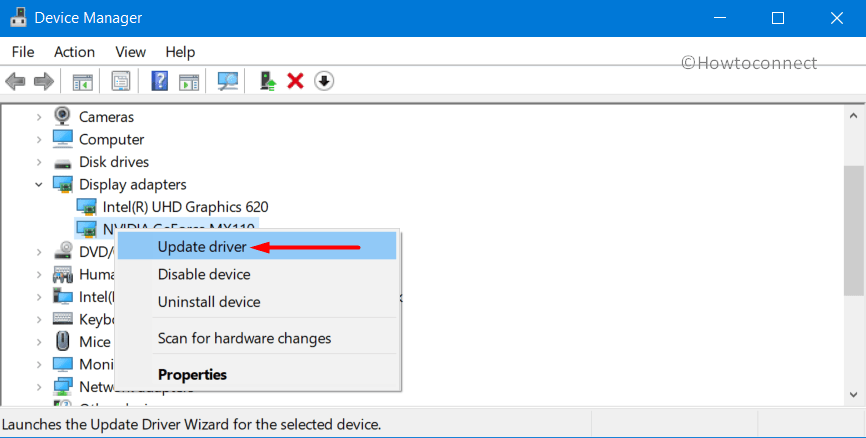
- The updating process will begin immediately and you can complete some more tasks according to guidelines shown.
- Restart the device upon accomplishing the updating process.
6] Download and Install all available patches to Fix EFS_FATAL_ERROR
Microsoft releases regular patches containing the latest features, modification and most importantly, addresses bugs and problems. This is quite important to keep the Windows updated as an outdated OS can be easy prey to BSOD errors like EFS FATAL ERROR. The task is a quite easy proceeding through the Windows Settings app. To install these patches, proceed with following –
Important- Get the device connected with a high-speed internet connection to limit time consumption while downloading. You can better use a Wi-Fi or broadband connection. In case of using the Mobile hotspot, disable the Metered Connection first, otherwise, the process will not begin.
Step#1: Do press the Windows key and let the Start menu arrive.
Step#2: Perform a click on the Settings icon to access the built-in app.
Step#3: When in the accessible area, proceed to Update & Security and hit a click on it.
Step#4: Moving ahead to the consequent page, choose Windows Update from the left side wing.
Step#5: Jump to the adjacent right and make a click on Check for updates button. Don’t be confused with visible dialog “You’re up to date”.

Step#6: When all the update files are available on this page, choose the Download button.
Step#7: Installation begins automatically when downloading finishes.
Step#8: Keep the device manned always to attend timely restarting.
7] Repair Corrupted System elements and recover missing DLL files
Corruption in the system can occur in many ways. The system might lose the DLL files as well and these reasons call up EFS_FATAL_ERROR BSOD Windows 10. We resolve these problems using the System File Checker tool. To access the tool, the guidelines are as follows –
- Open up the Taskbar Search by pressing Windows and S keys together.
- When it arrives on display, type cmd in the provided text box.
- Once Command Prompt peeks in the result, make a right click on it.
- Select Run as Administrator option to proceed ahead.
- When UAC asks for permission, choose Yes to give consent.
- On the black window next, type the following command and hit Enter button from the keyboard –
sfc /scannow
- The action will execute System File Checker immediately. The tool will detect the issues in files and also fix them automatically.
- The process might take a while and you need to be patient till it ends normally.
- Restart the device when it gets over and check for the issue once sign back in next.
In the process, the said BSOD error will disappear hopefully.
8] Run the Memory Diagnostic Tool to Resolve EFS FATAL ERROR
The wrong allotment of Memory, corruption in the Random Access Memory (RAM) has active participation in causing EFS_FATAL_ERROR BSOD Windows 10. Before it becomes late, we need to step out to resolve these areas. Default Windows Memory Diagnostic Tool is well reputed for handling those cases. See the method below –
- Get access to the Settings app using any of the aforementioned ways.
- In the app UI, you will see a search box provided.
- Type memory in here and select Diagnose your computer’s memory problems from the dropdown menu.
- When the tool arrives, go ahead with the option namely “Restart now and check for problems (recommended)”.
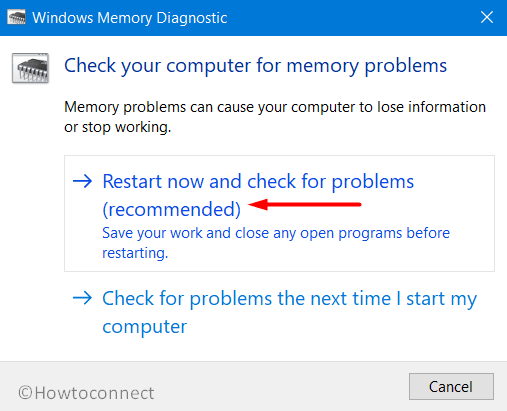
- Windows will now reboot initially first. When it returns to operation, you will notice a blue screen detecting memory issues in the system.
- When the progress becomes 100%, the OS will reboot again for the second time. After coming back to operation again, the result of the diagnosis will be available in the System Tray- Notification area.
9] Disconnect Hardware components away from PC and Reconnect in order
People have also come across EFS_FATAL_ERROR BSOD Windows 10 after they have started using an additional Hard Drive. Similar issues came up while using additional DVD drive as well. It might happen in your cases too and the resolution is pretty simple. Only the disconnection resulted in disappearing the issue. So, we recommend to disengage all of those and again reconnect using correct guidelines as follows –
- First of all, disconnect all the Hardware Accessories and leave them in a safe place with cables.
- Open the Start menu by pressing the Windows key at once.
- In the menu, make a click on the Power cog and select Restart as well.
- Windows will reboot normally and when it turns back to operation, perform a check for BSOD issue in the system.
- If nothing comes up, connect all of the separated Hardware items one by one.
- Launch a web browser and visit the manufacturer website for each item separately.
- Download the drivers on the computer and eventually install them again.
10] Uninstall similar programs causing Conflicts
Presence of two or more similar programs can be highly risky since they often come in contact with each other. In the process, they collide and finally delete useful OS components. You might have faced EFS_FATAL_ERROR BSOD due to this reason. In that case, we need uninstall, those programs until error resolves finally. Here is how to proceed for that-
- Invoke the Run dialog in the display by pressing Windows and R keys together.
- In the empty search field, type appwiz.cpl and hit the Enter key.
- Programs and features will flash up and the list of install apps will be available.
- Move out for programs causing EFS_FATAL_ERROR BSOD Windows 10.
- Do a right click on each and select Uninstall option when visible.
- Perform the next tasks as asked in desktop until the process finishes.
- Once uninstalled successfully, perform a restarting of Windows in a normal way.
- Upon starting again, check if the error resolved. If yes, download and install the program again if you like.
11] Use the Disk Cleanup Utility to delete unnecessary junk files
Windows produces temporary files for the execution of tasks and these are stored in the disk space. When they pile up largely, take most of the space in a drive. As they are unnecessary, they need to be removed. Furthermore, due to lack of space, a regular operation is disturbed and EFS FATAL ERROR BSOD errors rise up. Using Disk Cleanup utility can simplify the task as it can delete all the junks together in a single click. To accomplish the task, guidelines are as follows –
- Do a combined press of Windows key and R from keyboard to invoke Run dialog.
- In the box provided for typing here, write cleanmgr.
- Press the Enter key and immediately, a small popup dialog will appear.
- It will be asked to choose the drive name where Cleanup will be carried out.
- Select C: by clicking on the dropdown menu and hit Ok button.
- The tool will first calculate the total amount of space in Drive C: it can recover and then shows a popup wizard.
- Moving ahead to the wizard, come down to the bottom left end of it and select Clean up system files.
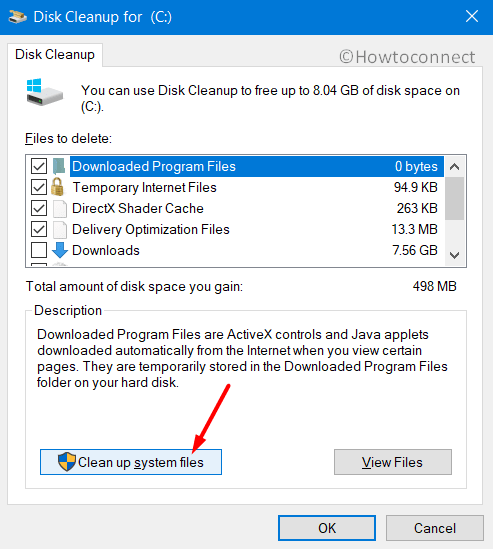
- Once more time the small popup will float up asking for the preferable drive. Choose C: again and hit Enter key.
- After calculating retrievable space in it, again the Disk Cleanup for (C:) will appear.
- On the window, check all the items under Files to delete except Downloads only.
- At this moment, check in the Recycle Bin and also move any important files to its designated location.
- Now, coming back to wizard again, do select Ok button to initiate cleanup.
This is a little bit slower process and might take a good amount of time to accomplish. Wait until it finishes normally and doesn’t terminate.
12] Go back to a previous Restore point and fix EFS_FATAL_ERROR BSOD
You might have faced EFS FATAL ERROR BSOD Windows 10 after making some changes in the device. Uninstalling a program or installing another leaves marks in Windows Registry. When anything goes out of control, you might find BSOD error in the system. In such condition, you can go back to the previous restore point and undo all the recent changes.
Note – For this workaround, it’s mandatory to possess a previously created System Restore Point. If you lack that, you may proceed to the next process. Fortunately, if you have, move with below guidelines –
- Open the Taskbar Search using any of the previously mentioned guidelines.
- Type rstrui in the null text field and also hit Enter key.
- When the System Restore wizard is upfront, hit the Next button to move ahead.
- From the consequent page, choose option Show more restore points to see all available points.
- Choose the latest one created followed by hitting Next.
- After the succeeding page comes in, scroll down to the bottom and choose Finish to begin the process.
13] Resolve the poor areas in the Hard Disk Drive
Hard Drive itself prone to have defective areas in it as of using for a long time. If such case happens with you, might experience EFS_FATAL_ERROR BSOD Windows 10 also. In that respect, we can fix up those areas using Disk Checking Tool executed in the Elevated Command Prompt. For accessing the tool, see the method below –
- Press Ctrl+Alt+Del keys together and a startup screen will arrive.
- Select Task Manager from there and launch the app separately.
- In the user interface, do a click on File located at the top left corner.
- Choose Run a new task option.
- When a dialog opens, type cmd in the empty box.
- Check the box before “Create this task with administrative privileges” next.
- Hit Enter key then to head to Elevated Command Prompt directly.
- On the next dark window, type the command in below arrangement –
chkdsk [Drive:] [parameters]
- Once you hit Enter, the Command Prompt will show the Disk status only. Since we are up to a target of fixing the bad areas, the command needs some notations like –
/f /r /x
- Here, “f “will fix the brought up issues in the disk. “r” will detect the issues present and the last one “x” will split up the whole Disk volume before the utility take action.
- C: is present here as we have OS installed in this drive. If you have done it in another one, put D:, E: or F:.
So, the final command seems like – chkdsk C: /f /r /x
- Now, press Enter key to start the process, it will take almost 10 minutes to accomplish fully.
- Wait patiently and when ends, do a normal restart to Windows so that all changes are effective.
- When the PC powers up next, check if there are any issues like EFS FATAL ERROR BSOD Windows 10.
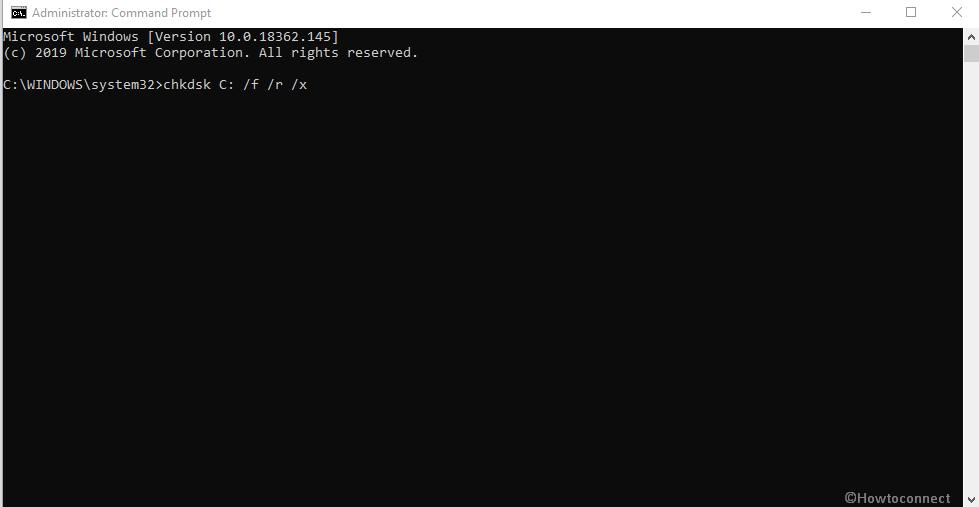
14] Uninstall all third-party anti-malware tool from System
Since Microsoft provides Windows Security app to deal with virus issues, apparently, there is no need of any third party anti-malware tool. Moreover, while using them, you might get EFS FATAL ERROR BSOD Windows 10. Therefore, uninstall them immediately using the below guidelines –
- Do a combined press of Win+I hotkeys to access the Settings app.
- Move ahead to the Apps tile and make a click on it.
- When the succeeding page loads fully, select Apps & features located at the left overlay.
- Moving ahead to the corresponding pane, you will come across the installed apps list.
- Reach out to the third party anti-malware program and select the same.
- Hit Uninstall option from expanded pane to continue.
- Choose Yes once UAC prompts up for permission.
- Complete the task by co-operating with guidelines shown on the desktop screen.
15] Uninstall all the problematic Windows update files
Updating process in Windows operating system is autonomous and it generally doesn’t end up at the midway of installation. Yet, sometimes people experience this abnormal termination of the process. This will cause EFS_FATAL_ERROR BSOD Windows 10 to evolve as well. The best remedy in this respect is to delete them all from the computer. Here are the steps to be followed –
- Launch the built-in Settings app using any available instruction given above.
- From the app area, move out for Update & Security tile and finally do a click on it.
- Once the consequent page loads, choose Windows Update from the left pane and transfer self to right.
- When in the place, perform a click on the link saying View update history.
- After the succeeding page unrolls, select Uninstall updates link available here.
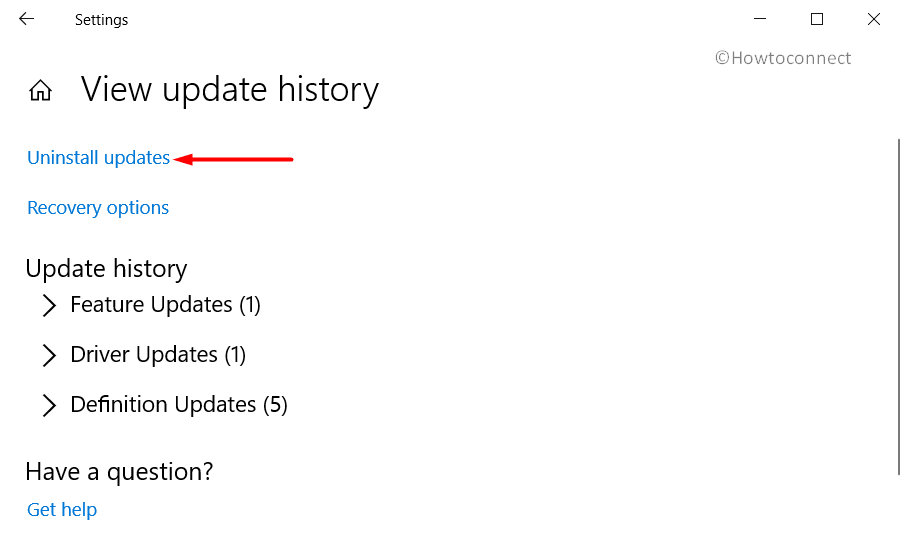
- By default, the action will open up Programs and features window.
- In due course, do a right click on the last patch you have downloaded.
- Select Uninstall option from there to proceed.
- Finish up the task by following upcoming guidelines on display.
16] Execute the DISM Tool to fix up EFS FATAL ERROR
In some worst scenarios, Windows Image files may run into corruption. If that happens so EFS_FATAL_ERROR BSOD Windows 10 will appear in the system as well. The best way to resolve this is to run the Deployment Image Servicing and Management. To access the utility, the guidelines are as follows –
- Manage the entry to the Elevated Command Prompt using any of the above instructions.
- When in the dark window, type the following command line tool at the place where the cursor is winking –
DISM.exe /Online /Cleanup-image /Restorehealth
- Finally, Press Enter key to execute the tool.
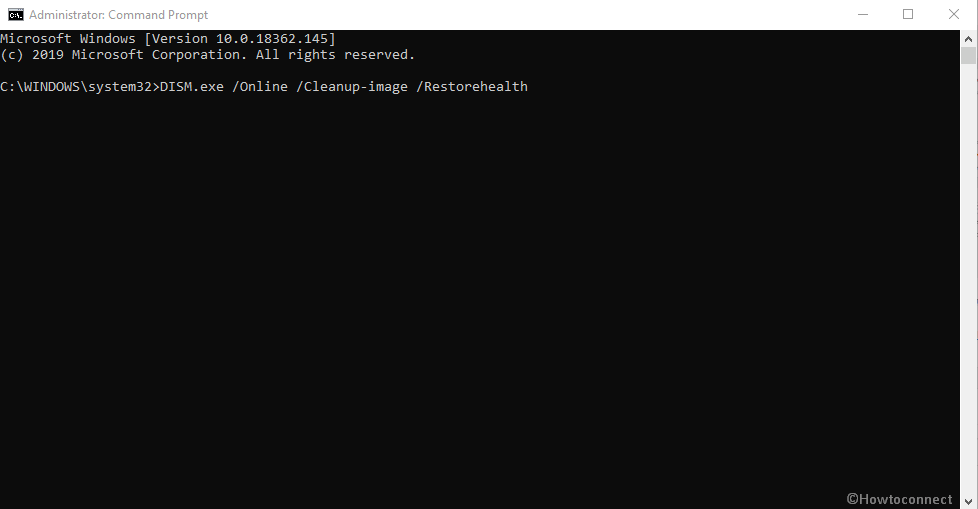
This process will take a little longer and thus you need to show enough patience until it ends up.
Once the process finishes, restart Windows 10 PC and afterward, see if there are any issues. Hopefully, you will not come across anything.
Finally, we have arrived at the point of closing all the workarounds. Above part, we have already discussed all probable and effective workarounds aiming to resolve EFS_FATAL_ERROR BSOD Windows 10. Hopefully, you have fixed the issue and having a really refreshing time. In some cases, there might be exceptions and you can be failed to resolve the error also. In that case, we can suggest the last resort and that is performing Clean Installing of Windows 10 again. This workaround though being a little bit professional can provide a flawless PC afterward if done perform perfectly.
Before proceeding to do the task, make sure the computer is connected with a speedy internet connection. Most importantly, save a backup for all the necessary items in the system and preferably take it out carrying in USB or external drive. Perform the task with the utmost care, seek help from skilled people if you feel nervous. We can assure you an error-free device if done this process accurately.
Methods:
1] Restrict Windows 10 From Automatic Rebooting
2] Enter Safe Boot Mode to load basic applications only
3] Use Windows Blue Screen Troubleshooter
4] Dismiss viruses via Windows Security
5] Update all the drivers
6] Download and Install all available patches
7] Repair Corrupted System elements
8] Run the Memory Diagnostic Tool
9] Disconnect Hardware components
10] Uninstall similar programs causing Conflicts
11] Use the Disk Cleanup Utility to delete unnecessary junk files
12] Go back to a previous Restore point
13] Resolve the poor areas in the Hard Disk Drive
14] Uninstall all third-party anti-malware tool from System
15] Uninstall all the problematic Windows update files
16] Execute the DISM Tool
That’s all!!
